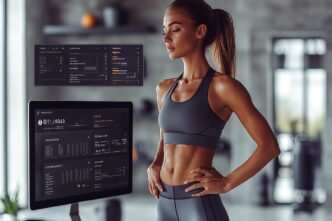Executive Summary
The Trajectory So Far
The Business Implication
Stakeholder Perspectives
Artificial intelligence is rapidly transforming the wellness landscape, offering unprecedented opportunities for individuals to achieve their health goals through hyper-personalized workout and meal plans. This technological shift empowers anyone seeking optimized fitness and nutrition outcomes by leveraging sophisticated algorithms that analyze individual data, adapt to progress, and provide dynamic recommendations. Available now through a growing array of digital applications and smart devices, AI-powered solutions are emerging as a critical tool for those who desire more effective, adaptable, and data-driven approaches to personal well-being.
The AI Revolution in Personal Health
The integration of AI into health and wellness marks a significant evolution from generic fitness advice to highly individualized programs. For decades, personal trainers and nutritionists have offered bespoke guidance, but the scalability and data processing capabilities of AI are creating new benchmarks for personalization. This technological leap democratizes access to tailored plans that were once the exclusive domain of elite athletes or high-net-worth individuals.
AI’s strength lies in its ability to process vast amounts of data, identify complex patterns, and make informed decisions at a speed and scale impossible for human experts. This capability is precisely what makes it so effective in crafting fitness and nutrition strategies that genuinely resonate with an individual’s unique physiology, preferences, and goals.
How AI Personalizes Your Workouts
AI-driven workout planning begins with comprehensive data collection, drawing information from various sources. This includes direct user input about fitness levels, past injuries, preferred exercise types, and time availability. Crucially, it also integrates data from wearables like smartwatches, which track heart rate, sleep patterns, activity levels, and calorie expenditure.
Intelligent Data Analysis and Adaptation
Once data is collected, machine learning algorithms analyze it to create a baseline profile. This profile informs the initial workout regimen, but the real power of AI emerges through its dynamic adaptation. As you progress, the AI continuously monitors your performance, looking for improvements, plateaus, or signs of overtraining.
If you consistently exceed expectations, the AI might suggest increasing intensity, adding more repetitions, or introducing new, more challenging exercises. Conversely, if you’re struggling, it can scale back the difficulty, recommend rest days, or modify movements to prevent injury. This real-time feedback loop ensures that your plan is always optimized for your current state and evolving capabilities.
For example, an AI might detect that your squat form is deteriorating based on accelerometer data from a smart sensor, prompting a tutorial on correct posture or suggesting a lighter weight. This granular level of feedback far surpasses what a human trainer could provide remotely or consistently.
How AI Personalizes Your Meal Plans
Crafting the perfect meal plan with AI is a multifaceted process that considers far more than just calorie counts. It starts with an in-depth nutritional assessment, where users input dietary preferences, allergies, health conditions (e.g., diabetes, hypertension), and specific goals like weight loss, muscle gain, or improved energy levels.
Generating Tailored Nutritional Strategies
AI algorithms then leverage extensive food databases to generate meal suggestions that meet precise macronutrient and micronutrient targets. This includes balancing proteins, carbohydrates, and fats, alongside ensuring adequate intake of vitamins and minerals. The system can also account for food availability, budget constraints, and even your cooking skill level.
Beyond simple recommendations, AI can generate detailed recipes, complete with step-by-step instructions and shopping lists. It can also suggest substitutions for ingredients you don’t like or can’t find, ensuring flexibility and adherence. Some advanced systems even consider your genetic predispositions to certain foods or nutrient absorption rates, pushing personalization to an even deeper level.
For instance, if you indicate a preference for plant-based meals and a goal of increasing protein intake, the AI might suggest a lentil and quinoa bowl recipe rich in essential amino acids, factoring in your local grocery store’s inventory for fresh produce availability.
The Core Technologies Driving AI Fitness
The sophisticated personalization offered by AI in fitness and nutrition is underpinned by several key technological advancements. Machine learning, a subset of AI, is central to this process. It enables systems to learn from data without explicit programming, constantly improving their recommendations.
Machine Learning and Data Analytics
Supervised learning models are trained on vast datasets of successful workout and meal plans paired with user outcomes, allowing them to predict effective strategies. Reinforcement learning, on the other hand, allows the AI to learn through trial and error, adjusting plans based on the positive or negative feedback it receives from your body’s response. Big data analytics plays a crucial role by identifying trends and correlations across millions of user profiles, refining the algorithms’ understanding of human physiology and behavior.
Natural Language Processing (NLP) is also vital, especially for user interaction. NLP allows AI systems to understand and process human language, enabling intuitive input of dietary restrictions, preferences, and feedback. This makes the interaction feel more natural and less like filling out a rigid form.
Benefits of AI-Driven Fitness and Nutrition
The advantages of using AI for personalized wellness are numerous and compelling. Firstly, the level of personalization is unparalleled, offering plans that adapt in real-time to your body’s responses and your lifestyle changes. This leads to significantly increased efficiency and effectiveness compared to one-size-fits-all programs.
Accessibility, Motivation, and Data-Driven Insights
AI solutions make expert-level guidance more accessible and often more affordable than traditional personal coaching. Many apps offer subscription models that are a fraction of the cost of a human trainer or nutritionist. The dynamic nature of AI plans also helps maintain motivation and engagement, as users see their progress reflected in constantly evolving challenges and goals.
Furthermore, AI provides invaluable data-driven insights into your health journey. Users can track progress, identify patterns in their habits, and understand the impact of specific workouts or foods on their bodies. This empowers individuals to make more informed decisions about their health.
Challenges and Considerations
Despite its immense potential, AI in fitness and nutrition is not without its challenges. Data privacy and security are paramount concerns, as these systems collect highly sensitive personal health information. Users must choose platforms with robust security measures and clear data handling policies.
Accuracy, Bias, and the Human Element
The accuracy and potential bias of algorithms are another consideration. If an AI system is trained on biased data, its recommendations might not be universally applicable or could even perpetuate unhealthy stereotypes. There is also the inherent lack of human empathy and nuanced understanding that a human coach can provide, especially when dealing with complex psychological factors related to food and exercise.
Over-reliance on technology can also be a pitfall, potentially diminishing an individual’s intuitive understanding of their own body. Ethical implications, such as the potential for AI to contribute to body image issues if not carefully designed, also warrant careful consideration from developers and users alike.
Choosing the Right AI Fitness Platform
When selecting an AI-powered fitness and nutrition platform, several factors should guide your decision. Look for platforms with a strong reputation for scientific backing and transparency in their methodologies. Investigate their data privacy policies to ensure your personal information is protected and used ethically.
Consider the level of customization offered and how well it integrates with your existing wearables or smart devices. User interface and ease of use are also important for long-term adherence. Finally, evaluate the cost and subscription models to ensure they align with your budget and provide good value for the features offered.
The Evolving Landscape of Personalized Wellness
AI’s role in crafting personalized workout and meal plans is set to expand dramatically. Future iterations will likely integrate with medical records for even more precise recommendations, incorporate predictive health analytics to proactively prevent ailments, and offer even more immersive and interactive experiences through virtual and augmented reality. The ongoing advancements promise a future where personalized wellness is not just a luxury, but an accessible standard for all.








